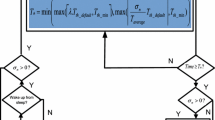Abstract
There is a considerable interest nowadays in improving energy efficiency of wireless telecommunications. The sleep-mode mechanism in WiMAX (IEEE 802.16) and the discontinuous reception (DRX) mechanism of LTE are prime examples of energy saving measures. Recently, Samsung proposed some modifications on the sleep-mode mechanism, scheduled to appear in the forthcoming IEEE 802.16m standard, aimed at minimizing the signaling overhead. In this work, we present a performance analysis of this proposal and clarify the differences with the standard mechanism included in IEEE 802.16e. We also propose some special algorithms aimed at reducing the computational complexity of the analysis.






Similar content being viewed by others
References
IEEE 802.16e-2005. (2006). Part 16: Air interface for fixed and mobile broadband wireless access systems—Amendment 2: Physical and medium access control layers for combined fixed and mobile operation in licensed bands—Corrigendum 1, February 2006.
The Draft IEEE 802.16m system description document, IEEE 802.16m-08/003r4, July 2008.
Sleep mode operation for IEEE802.16m, C802.16m-08/721r1, July 2008.
Keep-awake mechanism for 802.16m sleep mode, C802.16m-08/718, July 2008.
Xiao, Y. (2005). Energy saving mechanism in the IEEE 802.16e wireless MAN. IEEE Communications Letters, 9(7), 595–597.
Zhang, Y., & Fujise, M. (2006). Energy management in the IEEE 802.16e MAC. IEEE Communications Letters, 10(4):311–313.
Han, K., & Choi, S. (2006). Performance analysis of sleep mode operation in IEEE 802.16e mobile broadband wireless access systems. In Proceedings of the IEEE 63rd vehicular technology conference (Vol. 3, pp. 1141–1145). VTC2006-Spring, Melbourne, May 7–10, 2006.
Park, Y., & Hwang, G.U. (2007). Performance modelling and analysis of the sleep-mode in IEEE 802.16e WMAN. In Proceedings of the IEEE 65th vehicular technology conference (pp. 2801–2806). VTC2007-Spring, Dublin, April 22–25, 2007.
Seo, J.-B., Lee, S.-Q., Park, N.-H., Lee, H.-W., & Cho, C.-H. (2004). Performance analysis of sleep mode operation in IEEE 802.16e. In Proceedings of the 60th vehicular technology conference (Vol. 2, pp. 1169–1173). VTC2004-Fall, Los Angeles, September 26–29, 2004).
Kwon, S.-J., Chung, Y. W., & Sung, D.K. (2003). Queueing model of sleep-mode operation in cellular digital packet data. IEEE Transactions on Vehicular Technology, 52(4), 1158–1162.
Lin, Y.-B., & Chuang, Y.-M. (1999). Modeling the sleep mode for cellular digital packet data. IEEE Communications Letters, 3(3), 63–65.
Lee, N.-H., & Bahk, S. (2005). MAC sleep mode control considering downlink traffic pattern and mobility. In Proceedings of the IEEE 61st vehicular technology conference (Vol. 3, pp. 2076–2080). VTC2005-Spring, Stockholm, May 30 to June 1, 2005.
De Turck, K., De Vuyst, S., Fiems, D., & Wittevrongel, S. (2008). Performance analysis of the IEEE 802.16e sleep mode for correlated downlink traffic. Telecommunication Systems, 39(2), 145–156.
De Vuyst, S., De Turck, K., Fiems, D., Wittevrongel, S., & Bruneel, H. (2009). Delay versus energy consumption of the IEEE 802.16e sleep-mode mechanism. IEEE Transactions on Wireless Communications, 8(11), 5383–5387.
De Turck, K., De Vuyst, S., Fiems, D., Wittevrongel, S., & Bruneel, H. (2009). Performance of the sleep-mode mechanism of the new IEEE 802.16m proposal for correlated downlink traffic. In Proceedings of Netcoop 2009, Lecture Notes in Computer Science (pp. 152–165), Eindhoven, The Netherlands.
Baccelli, F., & Brémaud, P. (1994). Elements of queueing theory: Palm-Martingale calculus and stochastic recurrences. Berlin: Springer.
Neuts, M. F. (1989). Structured stochastic matrices of M/G/1 type and their applications, Volume 5 of Probability: Pure and applied. New York: Marcel Dekker Inc.
Bini, D. A., Latouche, G., & Meini, B. (2005). Numerical methods for structured Markov chains. Oxford: Oxford University Press.
Van Loan, C. (1992). Computational frameworks for the fast Fourier transform, Volume 10 of Frontiers in applied mathematics. Philadelphia, PA: Society for Industrial and Applied Mathematics (SIAM).
Baugh, C. R., Huang, J., Schwartz, R., & Trinkwon D. (2001). Traffic model for 802.16 tg3 mac/phy simulations. Technical report, IEEE 802.16 Broadband Wireless Access Working Group.
Wittevrongel, S., & Bruneel, H. (1999). Discrete-time queues with correlated arrivals and constant service times. Computers & Operations Research, 26(2), 93–108.
De Vuyst, S., Wittevrongel, S., & Bruneel, H. (2002). Mean value and tail distribution of the message delay in statistical multiplexers with correlated train arrivals. Performance Evaluation, 48(1–4), 103–129.
Jung, E.-S., & Vaidya, N. H. (2008). Improving IEEE 802.11 power saving mechanism. Wireless Networks 14(3), 375–391.
Acknowledgments
The first and third author are Postdoctoral Fellows with the Research Foundation—Flanders (FWO—Vlaanderen), Belgium.
Author information
Authors and Affiliations
Corresponding author
Rights and permissions
About this article
Cite this article
De Turck, K., De Vuyst, S., Fiems, D. et al. Efficient performance analysis of newly proposed sleep-mode mechanisms for IEEE 802.16m in case of correlated downlink traffic. Wireless Netw 19, 831–842 (2013). https://doi.org/10.1007/s11276-012-0504-6
Published:
Issue Date:
DOI: https://doi.org/10.1007/s11276-012-0504-6




